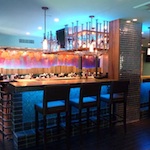At a Glance
Company headquarters
Balitmore, MD
Development department employees
6
Average project duration
13 weeks
Current locations
105
Since CEO Kevin Plank started the business out of his grandmother’s basement in the mid-1990s, Under Armour has come a long way, and so have its storefronts. After first operating as a wholesaler, selling top-of-the-line athletic apparel to retailers such as Dick’s Sporting Goods and Sports Authority, the company began to move into retail operations of its own. Under Armour had just 13 stores when Tom Walsh began working there in 2008, but largely thanks to an in-house development department that he created and now leads, that number has grown rapidly to 105. “It was an opportunity you get once in a lifetime,” Walsh says.
The company has two types of retail spaces: outlet stores and specialty locations. The 100 outlets, which sell excess product, offer a straightforward aesthetic suitable for a value shopper. At the five specialty stores, though, which take 13 weeks to build, the aesthetic is enhanced with innovative displays and lighting to create the real brand experience of Under Armour. “It gives us an opportunity to really show off the brand for what it is,” Walsh says. “It’s athletic, it’s performance, it’s badass.”
The ideal in-store experience at these specialty locations ties into a favorite catchphrase of Under Armour’s CEO. “He always says, ‘What do you want to be?’” Walsh says. “And on the design-build side, it’s our job to make sure that’s communicated. Under Armour consumers work extremely hard to become the best at their crafts. When they come into our stores, they should feel that they can do anything.”

To create this experience, Under Armour incorporates advanced technology meant to both impress and empower patrons. “We use technology to support our brand, to help the consumer get better,” Walsh says. Included in this push are high-performance sound systems, touch-screen displays, and, most notably, specialty lighting.
Lighting might seem like a simple design element, but Walsh says most of the lighting on the market today is trying to simulate natural light, and that’s not necessarily the light he wants to use in his specialty stores. “When designers of our products are selecting fabric, they’re seeing it under a certain type of light, whether it’s incandescent or halogen,” Walsh says, “and we want to show what the designer intended when we’re displaying the product in our store, so we go for that same effect.”
So, Walsh and his team have outfitted the entire supply chain—from where the fabric is selected to where it’s cut and sewn—to ensure that everyone is looking at the product under the same level of illumination. “We then carry that through to the store level,” Walsh says. “It ensures consistency throughout the full life cycle.”
Under Armour is working directly with Philips Light to develop a customized lamp for this program, and the partnership exemplifies how Under Armour’s development team does business overall. Walsh’s crew is intentionally smaller, and it relies heavily on external partners who must work in collaboration.
“We bring everyone together at the beginning of the project, and we communicate throughout,” Walsh says. “That’s true design-build. You’re bringing all the right players together at the right time.” The result is a set of specialty stores that immediately enhance Under Armour’s company vision. ABQ
__________________________

Meet Tom Walsh
Where did you go to school?
I studied visual communications, which is essentially graphic design, at Ohio Dominican College in Columbus, Ohio. I’ve never worked a day in that field in my life. During senior year, I discussed my interests with some administrators, and before I knew it, I had an interview with NBBJ, which at the time was the third largest architectural firm in the world.
What was your first construction job?
It was at NBBJ. I had no experience in construction or architecture, so I did a little bit of everything. I immersed myself and learned about the industry for five years.
How did you wind up working for Under Armour?
During my last five years at NBBJ, I was working in the design-build group, doing corporate tenant-improvement projects. One of my clients was Abercrombie & Fitch, which eventually brought me on to work on new store concepts. One day, I ran into a former Abercrombie & Fitch colleague who had moved to Under Armour. She told me they were looking for a director of construction.
What personal goals do you have in your current role?
I want to get our specialty model to the same point as the outlet model. I could pretty much hit a button and an outlet store would open because the standards and processes are in place. I’d also like to get Under Armour retail into other global markets.


